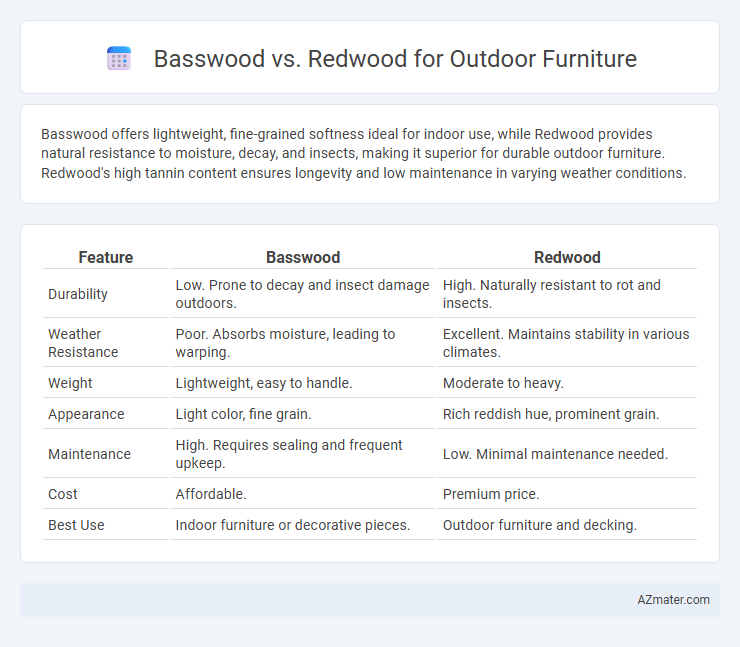Basswood offers lightweight, fine-grained softness ideal for indoor use, while Redwood provides natural resistance to moisture, decay, and insects, making it superior for durable outdoor furniture. Redwood's high tannin content ensures longevity and low maintenance in varying weather conditions.
Table of Comparison
| Feature | Basswood | Redwood |
|---|---|---|
| Durability | Low. Prone to decay and insect damage outdoors. | High. Naturally resistant to rot and insects. |
| Weather Resistance | Poor. Absorbs moisture, leading to warping. | Excellent. Maintains stability in various climates. |
| Weight | Lightweight, easy to handle. | Moderate to heavy. |
| Appearance | Light color, fine grain. | Rich reddish hue, prominent grain. |
| Maintenance | High. Requires sealing and frequent upkeep. | Low. Minimal maintenance needed. |
| Cost | Affordable. | Premium price. |
| Best Use | Indoor furniture or decorative pieces. | Outdoor furniture and decking. |
Introduction: Comparing Basswood and Redwood for Outdoor Furniture
Basswood and redwood are popular choices for outdoor furniture, each offering unique properties that impact durability and aesthetics. Basswood is lightweight and easy to work with, featuring a fine, even grain that allows for detailed craftsmanship. Redwood boasts natural resistance to decay and insects, making it an excellent option for long-lasting outdoor use in various weather conditions.
Wood Characteristics: Basswood vs Redwood
Basswood features a fine, even grain with a pale, creamy color that provides excellent workability and smooth finishes, making it ideal for detailed outdoor furniture designs. Redwood is prized for its rich reddish-brown hue, natural oils, and high resistance to decay and insect damage, ensuring durability in various weather conditions. While basswood is softer and less weather-resistant, redwood's density and stability offer superior longevity and low maintenance for outdoor applications.
Durability and Weather Resistance
Basswood offers limited durability and moderate resistance to moisture, making it less ideal for outdoor furniture exposed to harsh weather conditions. Redwood is highly durable and naturally resistant to decay, insects, and moisture, ensuring longevity in outdoor environments. Its dense grain and tannins enhance weather resistance, making redwood a superior choice for outdoor furniture compared to basswood.
Appearance and Natural Color
Basswood offers a light, creamy to pale yellow color with a smooth, fine grain that provides a clean and modern appearance for outdoor furniture. Redwood displays rich, reddish-brown hues with natural variations and a pronounced grain pattern, giving furniture a warm and rustic aesthetic. The natural oils in redwood enhance its color durability and resistance to weathering, maintaining its vibrant appearance over time compared to the more subtle aging of basswood.
Workability and Ease of Crafting
Basswood offers superior workability for outdoor furniture due to its soft texture, fine grain, and ease of cutting, shaping, and carving, making it ideal for detailed craftsmanship. Redwood, while harder and more durable, poses more challenges in crafting because of its dense grain and higher resin content, which can blunt tools more quickly. Both woods are workable, but basswood is preferred for intricate designs, whereas redwood suits simpler, sturdier constructions.
Maintenance Requirements
Basswood outdoor furniture demands minimal maintenance due to its natural resistance to pests and moderate weather durability, requiring occasional sealing to maintain its light color and smooth texture. Redwood furniture offers superior weather resistance and durability, needing regular cleaning and annual application of protective sealants or stains to prevent moisture damage and preserve its rich reddish hue. Both woods benefit from covered storage during harsh weather to extend lifespan and maintain aesthetic appeal.
Cost and Availability
Basswood furniture typically costs less than redwood, making it a budget-friendly option for outdoor settings. Redwood is more expensive due to its natural resistance to decay and insect damage, which enhances longevity outdoors. Availability of basswood is higher in regions with abundant hardwood forests, whereas redwood is more commonly sourced from the western United States, leading to variable supply depending on location.
Eco-Friendliness and Sustainability
Basswood and redwood differ significantly in eco-friendliness and sustainability for outdoor furniture. Basswood is a fast-growing hardwood harvested from sustainably managed forests, making it a renewable and low-impact choice with minimal processing required. Redwood, on the other hand, grows slowly and is sourced primarily from old-growth forests, posing challenges for sustainability, though its natural resistance to decay reduces the need for chemical treatments.
Best Uses for Basswood and Redwood Outdoors
Basswood is lightweight and easy to carve, making it ideal for decorative outdoor furniture pieces that require intricate designs but are best used in covered or shaded areas to prevent moisture damage. Redwood features natural resistance to rot, decay, and insect infestation, making it well-suited for exposed outdoor furniture such as decks, benches, and patio sets that endure direct weather conditions. Both woods provide aesthetic appeal, but redwood's durability and weather tolerance make it the preferred choice for long-lasting outdoor applications.
Conclusion: Choosing the Right Wood for Your Outdoor Furniture
Basswood offers a lightweight and affordable option with moderate durability, making it suitable for decorative outdoor furniture in sheltered areas. Redwood provides superior resistance to decay and insects, ideal for long-lasting outdoor furniture exposed to harsh weather conditions. Selecting the right wood depends on balancing budget, environmental exposure, and desired longevity for your outdoor furniture projects.

Infographic: Basswood vs Redwood for Outdoor Furniture
 azmater.com
azmater.com